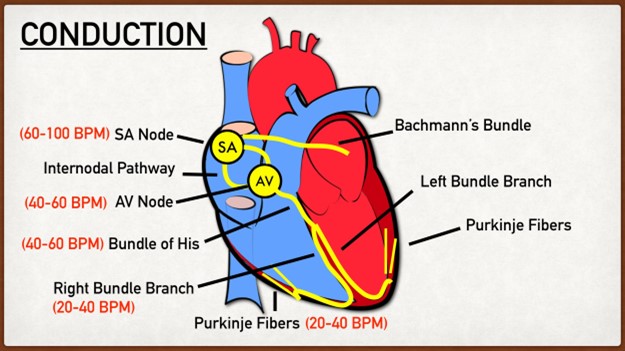The correct sequence of parts that carry cardiac impulses is:
AV node, SA node, Purkinje fibers, AV bundle.
SA node, Purkinje fibers, AV node, AV bundle.
SA node, AV node, AV bundle, Purkinje fibers.
AV node, AV bundle, Purkinje fibers, SA node.
The Correct Answer is C

This sequence ensures that the atria contract before the ventricles and that the ventricles contract from the bottom up.
Choice A is wrong because it reverses the order of the SA node and the AV node. The SA node is the pacemaker of the heart and initiates the cardiac impulses.
Choice B is wrong because it places the Purkinje fibers before the AV node.
The Purkinje fibers are the last part of the conduction system and stimulate the ventricular muscle fibers.
Choice D is wrong because it reverses the order of the entire sequence.
The AV node is not the pacemaker of the heart and does not initiate cardiac impulses.
Nursing Test Bank
Naxlex Comprehensive Predictor Exams
Related Questions
Correct Answer is B
Explanation
A hormone is a secreted molecule that is carried in the bloodstream to where it acts on target cells that bear specific receptors for that hormone.
This definition is consistent with the dictionary and encyclopedia sources.
Choice A is wrong because it contradicts the definition of a hormone.
Hormones are not just any secreted molecules, but ones that have specific effects on cells with matching receptors.
Correct Answer is D
Explanation
It is measured as part of a blood test and depends on the number and size of red blood cells. It is normally 40.7–50.3% for males and 36.1–44.3% for females.
Red blood cells contain hemoglobin, which transports oxygen and nutrients to the cells and tissues of the body.
Choice A is wrong because the color of plasma is not hematocrit.
Plasma is the liquid part of blood that carries blood cells and other substances.
Choice B is wrong because hematocrit is not a disease.
It is a test that can indicate conditions such as anemia or polycythemia.
Choice C is wrong because hematocrit is not a clotting factor.
Clotting factors are proteins that help the blood to clot and prevent bleeding.
Whether you are a student looking to ace your exams or a practicing nurse seeking to enhance your expertise , our nursing education contents will empower you with the confidence and competence to make a difference in the lives of patients and become a respected leader in the healthcare field.
Visit Naxlex, invest in your future and unlock endless possibilities with our unparalleled nursing education contents today
Report Wrong Answer on the Current Question
Do you disagree with the answer? If yes, what is your expected answer? Explain.
Kindly be descriptive with the issue you are facing.
